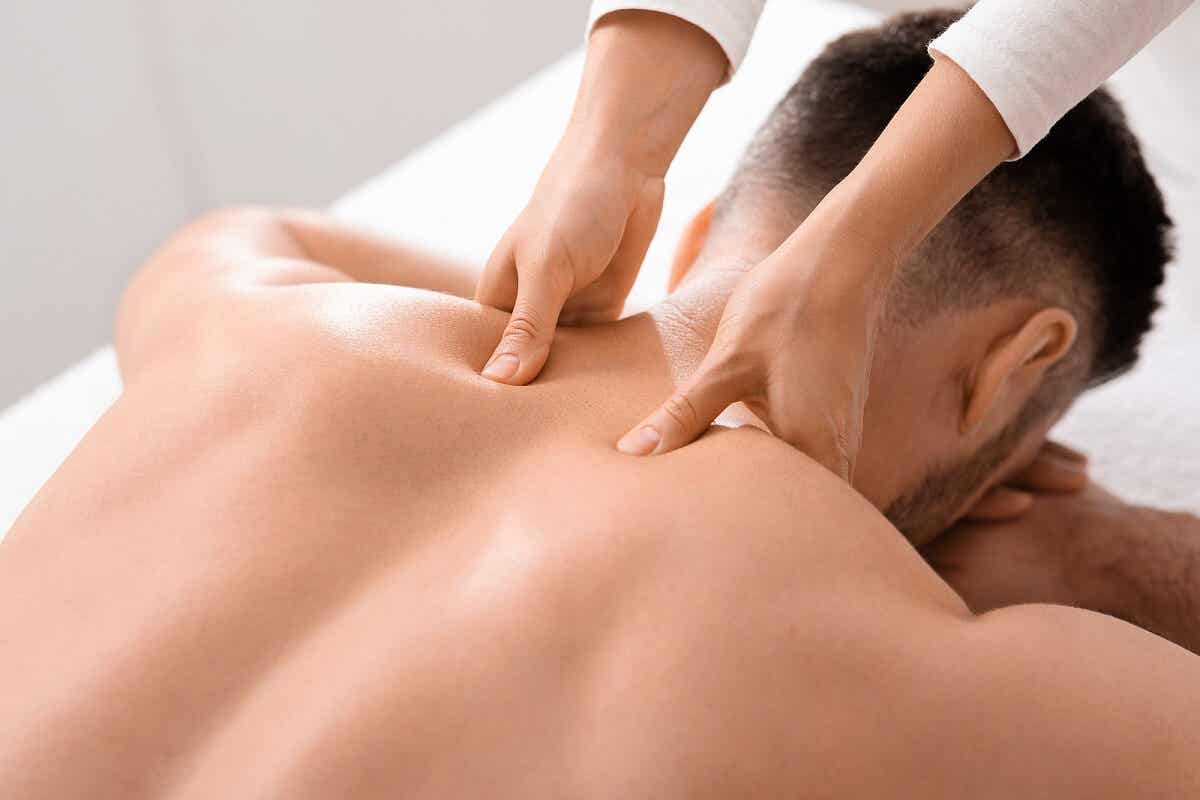The Benefits of Deep Tissue Massages

Massages are techniques for manipulating the superficial and deep muscle layers. From this, multiple methods have been created with great results. Among these, deep tissue massages are becoming more and more popular.
Their goal is to impact and relax the deepest surface of the muscle and fascia.
So, what are the benefits of this type of massage? When is it recommended? What are its contraindications?
Today, we want to answer all of these questions. Learn to release muscle tension in this article!
The benefits and uses of deep tissue massages
There are several benefits and uses of deep tissue massages. As stated in a study published in the Western Journal of Medicine, its mainly a tool for relaxation, relieving muscle disorders, and anxiety reduction. Are there other effects? We’ll tell you more below.
Pain relief
Deep tissue massages help eliminate knots in muscles and connective tissue. This helps relieve pain, at least temporarily. Specialists recommend it to help with joint discomfort and all kinds of chronic muscle pain.
Relaxation and well-being
Good muscle health leads to a state of maximum relaxation. In that sense, deep tissue massages are beneficial, since they stimulate the release of neurotransmitters that promote well-being.
In particular, it helps increase the release of dopamine, serotonin, and endorphins. Therefore, it can be used as a way to fight stress and anxiety.

Sports performance
Muscles’ range of motion in exercises will improve without built-up tension. As a result, your chances of losing calories and toning go up.
A study published in North American Journal of Sports Physical Therapy suggests that massages help prepare athletes for competition because it helps improve their performance. Also, it helps with recovery after exercising and reduces the risk of injury.
Sleep quality
Rest is the basis for high performance the next day, no matter what activity you’re doing. In this regard, deep tissue massages can serve as a complement to promote deep and restorative sleep. This is because it reduces pain and inflammation in specific areas. In addition, it increases the secretion of serotonin.
Injury relief
According to a publication in the Journal of Athletic Training, massages can reduce inflammation, as well as reduce the pain of muscle injuries. Specifically, deep tissue massages help treat the following injuries:
- Tennis elbow
- Muscle contractions
- Lumbago
- Back pain
- Neck pain
Check these out: What is Hot Stone Massage and What Are the Benefits?
How deep tissue massages are done
First, before you can do a deep tissue massage, you have to identify the precise area where the problem is. Then, the professional will ask the person to lie on their stomach or their back, depending on the area they’re treating.
It all starts with warming up the muscles with light touches. After that, start slowly kneading (with thumbs, knuckles, elbows, and forearms) and intense pressure- with some variability- to reach the desired depth.
Normally, these massages last between 60 and 90 minutes, which will depend on the amount of tension and the location. Finally, it’s important to note that this type of massage uses a lot of pressure, even more pressure than a Swedish massage. However, the sensation has a lot to do with how sensitive the patient is.
Does it hurt?
Deep tissue massages performed with the perfect technique shouldn’t hurt. However, obviously, some people might not like the feeling of getting some knots out.
The truth is that you might be sore the next day. However, it isn’t a problem, and your muscles should start feeling better almost immediately.

You might be interested in: Massaging Your Ear to Get Stress Relief
Contraindications and recommendations
As for contraindications, people with blood clots or who are prone to them shouldn’t get deep tissue massages. Also, those who suffer from osteoporosis need to consult a doctor first to determine the viability of a massage with these characteristics.
In addition, it’s a good idea to avoid deep tissue massages on areas with the following conditions:
- Bruising
- Infections
- Rashes
- Tumors
- Abdominal hernias
Recommendations on deep tissue massages
For deep tissue massages to provide the benefits we mentioned, it’s a good idea to follow these tips:
- Stay hydrated. Before getting a massage, you need to drink enough water. That way, the muscle tissue is ready to be treated and responds in the best way.
- Keep getting massages. Establishing a massage session every 2 weeks will keep your muscles in optimal condition and prevent knots from appearing.
- Save some relaxation time. After the deep tissue massage, it’s best to wait 12 hours before training again. This way, you can get the benefits without damaging interruptions or relapses.
Final thoughts on deep tissue massages
Pregnant women shouldn’t get these massages, but a specialist doctor could suggest some adaptations, depending on the case. In turn, people who have gotten recent surgeries or chemotherapy processes need the approval of trained professionals.
If the massage is painful during and after, make sure to remember the pain you’re feeling so you can readapt or suspend getting the massages, if necessary.
All cited sources were thoroughly reviewed by our team to ensure their quality, reliability, currency, and validity. The bibliography of this article was considered reliable and of academic or scientific accuracy.
- Vickers A, Zollman C, Reinish JT. Massage therapies. West J Med. 2001;175(3):202-204.
- Crawford C, Boyd C, Paat CF, et al. The Impact of Massage Therapy on Function in Pain Populations-A Systematic Review and Meta-Analysis of Randomized Controlled Trials: Part I, Patients Experiencing Pain in the General Population. Pain Med. 2016;17(7):1353-1375. doi:10.1093/pm/pnw099
- Brummitt J. The role of massage in sports performance and rehabilitation: current evidence and future direction. N Am J Sports Phys Ther. 2008;3(1):7-21.
- Brattberg G. Masaje de tejido conectivo en el tratamiento de la fibromialgia. Eur J Pain. 1999.
- Brosseau L, Casimiro L, Milne S, et al. Masaje de fricción transversal profunda para el tratamiento de la tendinitis. Cochrane Database Syst Rev. 2002.
- Field T, Morrow C, Valdeon C, et al. El masaje reduce la ansiedad en pacientes psiquiátricos infantiles y adolescentes. Soy Acad Child Adolesc Psychiatry. 1992.
- Vernaza Pinzón, P. El Masaje Como técnica De intervención En El Manejo Del Dolor. Rev. Fac. Cienc. Salud Univ. Cauca. 2007. Disponible en: https://revistas.unicauca.edu.co/index.php/rfcs/article/view/894.
- Serrano M, Moreno M, Gaitán M, Susa A, Gómez J, Suárez G y Sánchez K. Efectos del masaje terapéutico sobre la ansiedad y el estrés en población pediátrica. Rev. Fac. Med. 2018. Disponible en: https://revistas.unal.edu.co/index.php/revfacmed/article/view/60323.
- Waters-Banker C, Dupont-Versteegden EE, Kitzman PH, Butterfield TA. Investigating the mechanisms of massage efficacy: the role of mechanical immunomodulation. J Athl Train. 2014;49(2):266-273. doi:10.4085/1062-6050-49.2.25
This text is provided for informational purposes only and does not replace consultation with a professional. If in doubt, consult your specialist.








